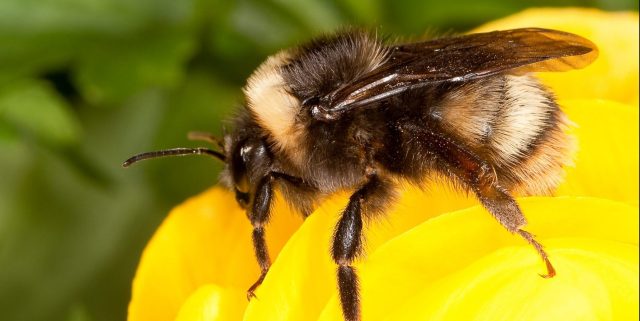25
Jan
Western Bumblebee Declines a Result of Pesticides and Climate Change, No End in Sight

(Beyond Pesticides, January 25, 2023) Populations of the western bumblebee are in free fall, with 57% declines across the species’ historical range, finds new research led by scientists at the U.S. Geological Survey. These data are in line with trends for other once common bumblebees in the United States, like the rusty patched and American, of which the former is now listed as endangered and the latter is under consideration. Most critically, the study authors did not simply generalize the most likely and common reasons, but instead establish the contribution that pesticide use, climate change, and land use changes have on western bumblebee declines. As the study shows, both the drivers and solutions to pollinators declines are in human hands, necessitating a broad rethinking of the nation’s approach to energy use and food production.
The western bumblebee has been under considerable stress for decades. In the 1990s, there were attempts to commercialize the species as a greenhouse pollinator. This industrial approach resulted in the spread of a fungal disease called Vairimorpha bombi, and captive rearing of the western bumblebee was eventually halted and deemed untenable. These dislocations resulted in local declines of the species in certain regions of U.S. Northwest and British Columbia.
While subsequent declines in the species have been attributed to a range of factors, the study authors note that no research has provided quantitative analysis of how land cover, climate change, and pesticide use both separately and simultaneously are affecting the western bumblebees population distribution. Using a range of analytical tools and survey data, the authors evaluate the occupancy range of the species in the U.S. studying changes in climate and land cover during the period 1998 to 2020 and pesticides use during the period 2008 to 2014. The trends found for these factors are then projected out to consider the future effect on the western bumblebee under a varying range of stressors.
Declines between 1998 and 2020 represent a 57% loss of occupancy throughout the bumblebee’s historical range, with the rate varying throughout different ecoregions. For example, while declines were found to be only 15% in the Greater Yellowstone Ecosystem, losses in the Madrean Sky Islands (mountain ranges than span Arizona, southwest New Mexico, and northwest Mexico) were recorded at 83%. Within the climate and land use model, the recorded temperature during the warmest season of the year had the greatest impact on declines, with a twofold greater negative impact than the next stressor – years of severe drought.
In regard to pesticide stressors, the study focuses only on the application of neonicotinoid pesticides within the species range. Without considering other pesticide stressors, occupancy in regions where neonicotinoid applications occurred are 35% lower than areas where these chemicals are not sprayed. Not only are they lower, but scientists found trends to indicate that local populations decrease alongside increasing neonicotinoid use.
The future does not look bright for these pollinators without considerable human intervention or change. “Future projections of B. occidentalis occupancy indicate continued declines in all modeled scenarios,” the authors write. Looking toward the year 2050, in the “most optimistic scenario,” where only climate change and land use continue to act as stressors, and there are no further impacts from pesticide use, declines would still be expected in 44% of the bee’s historical range, with no changes in 25% and some increases in 31%. It is worth noting that the increases are expected in regions already at their lowest population levels, and thus represent a very limited increase. In both the middle and worst-case scenarios with business as usual, continued declines are expected throughout the species’ entire range. As the authors indicate, “given that a complete abatement of extenuating factors beyond changes in climate and land cover would be extremely challenging to achieve, the middle- and worst-case future scenarios are more plausible outcomes.”
It is increasingly clear that humanity’s continued use of fossil fuels and fossil fuel-derived pesticides are the core drivers of pollinator declines. These are not siloed but interacting crises, creating a positive feedback loop and compounding one another’s harmful effects. Despite these stressors, alternatives are within reach. The authors note, “Current evidence suggests that use of these insecticides could be significantly curtailed without reducing crop yield and, in some cases, curtailment could even increase crop yield via insect-provided pollination services.” There is a long string of research finding little to no efficacy from many neonicotinoid uses, including a study published late last year that aligns with this approach, finding that pollination was more important for watermelon production than any level of pest management.
The authors stress the importance of pollinators in maintaining stable ecosystems, and the threat of trophic cascades when they are lost. Pollinators have coevolved with many flowers and help increase their growth and seed set. Loss of pollinators often coincides with the loss of mutually adapted flowers. This in turn, can affect other species like the sage grouse, which rely on early spring forbs, or the brown bear, whose diet may consist significantly of the roots of different flowers.
It must be highlighted that the threat of pollinator losses to the food supply and human health are not future concerns but present issues. Recent research finds 425,000 excess deaths each year can be attributed to pollinator declines caused by a lack of affordable healthy food. While low-income countries are the hardest hit economically from this decline, deaths are concentrated in middle and high income countries, accounting for now 1% of annual total mortality.
All unattributed positions and opinions in this piece are those of Beyond Pesticides.
Source: USGS press release, PNAS










